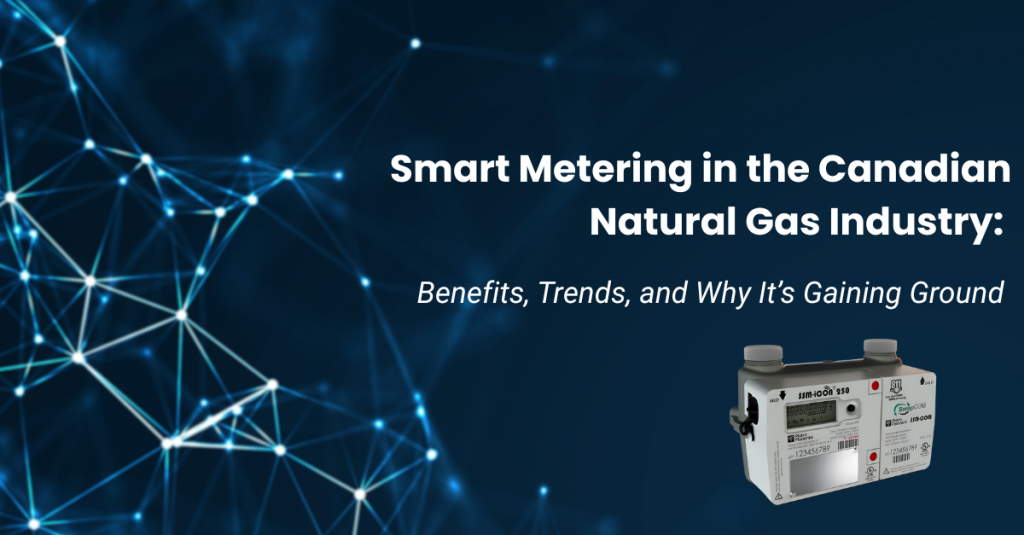
Smart metering, also known as Advanced Metering Infrastructure (AMI), is becoming an important part of modernization for Canada’s natural gas utilities. While the initial investment is significant, utilities are finding that the long-term benefits—ranging from operational savings to improved safety—make the technology a worthwhile strategic move.
For engineers, system planners, and decision makers, smart metering provides more than just accurate billing. It offers the data needed to improve system efficiency, support regulatory goals, and prepare for the future of energy distribution.
What is Smart Metering?
Smart meters are natural gas meters equipped with advanced communication and monitoring technology. Unlike traditional meters that require manual reading, smart meters provide automated and frequent readings without the need for site visits. They deliver wireless connectivity for seamless data transfer and can detect issues such as leaks, tampering, or unusual consumption patterns. In some cases, they also allow remote shut-off in emergencies. When paired with communication networks and data analytics, this technology forms the foundation of Advanced Metering Infrastructure (AMI).
Sources:
🔗 FortisBC – Benefits and Technology of Advanced Gas Meters
Case Example: FortisBC’s AMI Initiative
One of the most significant smart metering projects in Canada is currently underway at FortisBC. The utility is replacing more than 1.1 million gas meters between 2025 and 2028 in a large-scale modernization effort. The project represents an investment of approximately CAD $750 million, which was approved by the BC Utilities Commission. While the upfront cost is substantial, FortisBC projects savings of about CAD $322 million in operations and maintenance over the 26-year lifespan of the initiative, largely by eliminating manual meter reading. Beyond cost savings, the advanced meters incorporate ultrasonic measurement, wireless connectivity, and remote shut-off features, which can be particularly valuable during emergencies such as wildfires or floods. Together, these elements highlight how FortisBC is balancing capital investment with long-term operational efficiencies and improved system resilience.
Sources:
🔗 FortisBC – Advanced Gas Meters: What Customers Need to Know
🔗 BC Sustainable Energy Association – Smart Meters for FortisBC Gas Utility
Key Benefits of Smart Metering
Benefit | Details |
Operational Efficiency | Eliminates manual meter reading, reduces truck rolls and labour costs, cuts down on estimated billing, and improves asset management. |
Safety and Reliability | Detects abnormal consumption that may indicate leaks, provides tamper alerts to reduce theft, and enables faster response through remote shut-off. |
Customer Engagement | Ensures billing accuracy with fewer disputes, offers daily or near-real-time usage data, and reduces the need for property access. |
Environmental and Regulatory Alignment | Reduces GHG emissions from fewer truck visits, supports conservation and efficiency initiatives, and aligns with decarbonization strategies. |
Future-Ready Infrastructure | Enables flexible rate designs, predictive maintenance, IoT integration, and supports renewable natural gas (RNG) and hydrogen blending. |
Sources:
🔗 Smart Energy International – Canada’s FortisBC Energy Plans Rollout of 1 Million Smart Gas Meters
Demand Planning and Historical Data for System Capacity
One of the most impactful benefits of smart metering goes beyond billing accuracy and customer service: it provides the foundation for stronger demand forecasting and long-term system planning. Traditional meters, which typically provide only monthly or bi-monthly reads, limit the ability to model usage patterns. Smart meters, on the other hand, deliver daily or even hourly consumption data, creating a much richer historical record. This granular data allows utilities to build more accurate demand models, anticipate peak loads, and plan infrastructure upgrades with greater precision. Since most utilities plan gas supply and system capacity on a five- to ten-year horizon, the availability of smart meter data significantly strengthens the ability to project future needs. When combined with other factors such as population growth, industrial activity, and weather variations, this data supports scenario planning and provides a robust evidence base for regulatory filings. For utilities, this means more reliable capacity planning and stronger justification for future system investments.
Why It’s Gaining Popularity in Canada
- Aging infrastructure requires modernization after decades of limited change
- Regulators are pressing for reliability, safety, and emissions reduction
- Customers demand transparency, accuracy, and digital access to usage data
- Global momentum—with proven deployments in Europe and the U.S.—is pushing Canadian utilities to follow suit
- Environmental accountability adds urgency, with smart meters reducing truck rolls and supporting methane emissions tracking
Final Thoughts: The Future of Distribution
Smart metering is more than a technology upgrade, it is a strategic investment in the reliability, safety, and sustainability of Canada’s natural gas distribution systems.
For engineers and utility planners, the data provided by smart metering enables not only operational efficiencies but also accurate demand forecasting, long-term capacity planning, and regulatory compliance. For customers, it improves accuracy, transparency, and service.
As Canada’s energy sector continues its transition toward modernization and decarbonization, smart metering stands out as a foundational step in preparing natural gas utilities for the future.
Interested in exploring smart metering further? Explore our available smart metering and software products, or get in touch with our team to learn more.
